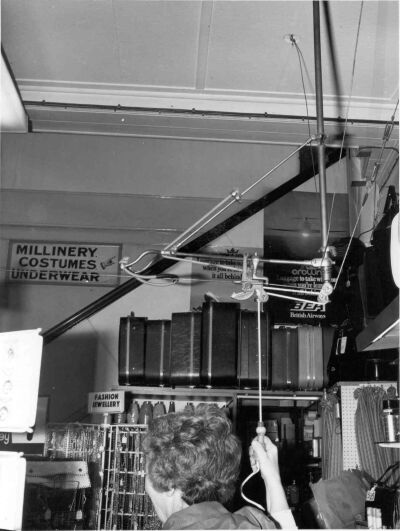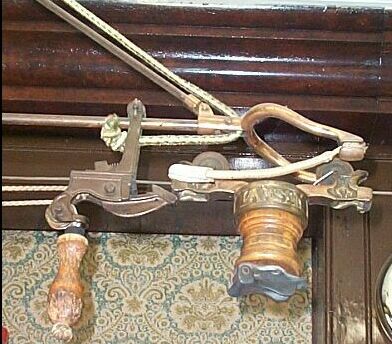THE CASH RAILWAY WEBSITE |
||||||||
| Home | Manufacturers | Cash Balls | Wire systems | Cable systems | Pneumatic systems | Locations | References | Patents |
Rapid Wire system
Robert McCarty of Detroit, Mich., took out a series of patents relating to wire carriers in 1884 and 1885. The invention was probably licensed to the Rapid Service Store Railway Company of Detroit. Lamsons took control of this company in 1887 and marketed the system under the name "Rapid". The Rapid Wire system was less intrusive than the Cash Ball system and needed less space at the cashier's office. Around 1912, Lamson's brochure B-1 claimed "over 50,000 stations in operation."
Lines could be up to 150 feet on the level or 100 feet on an incline. When the central desk was higher than the sales station, cars could be returned by gravity simply by releasing a catch. Lines could travel round curves and over bridges to avoid obstacles.
It was still being publicised in 1962. The Daily Telegraph of 30 December 1971 stated that there were 35 drapers shops in Britain leasing systems as well as others who had bought them. The last wire systems to be installed were probably Kick-back systems. The wire series also included the "Rapid" Lift (for cash and documents) and the 104 lift and 107 lift for papers in bulk. The papers at Beamish Museum also include a photograph of "an old D D Lamson Speedway Wire System" ahowing a cash desk serving six stations with one curve line.
A diagram and corresponding parts list are on display at Lamson's premises in Auckland.
 |
The cash was carried in a 'car' consisting of a wooden cup attached to a trolley. The Rapid Wire system used a single cable, the car being propelled by means of a catapult device (technically called a 'propulsion') at each end. This photograph of Anscombes in Harpenden shows the cashier's office, where the lines converged. As well as the six Rapid Wire propulsions there is one of the Gipe design, used for the station upstairs - possibly using the "Loop the Loop" system. It has a separate support and the handle is almost horizontal. Other examples of the central desk arrangement can be seen at the Bad Ass Cafe and the Museum of London. |
 |
This photograph of Anscombes shows the propulsion at the sales point. The cord passes round a pulley and pulls the slider along the rod towards the right, tightening the elastic which is fixed to the diagonal strut. At a certain point (adjusted for the distance of the journey) the catch releases and the car is launched on its way. |
 |
Close-up of the propulsion and car at Alfriston Post Office. (The elastic looks like a modern luggage tie.) |
 |
A gravity return which could be used when the central desk was elevated above the sales floor. Cars are returned by releasing a catch. |